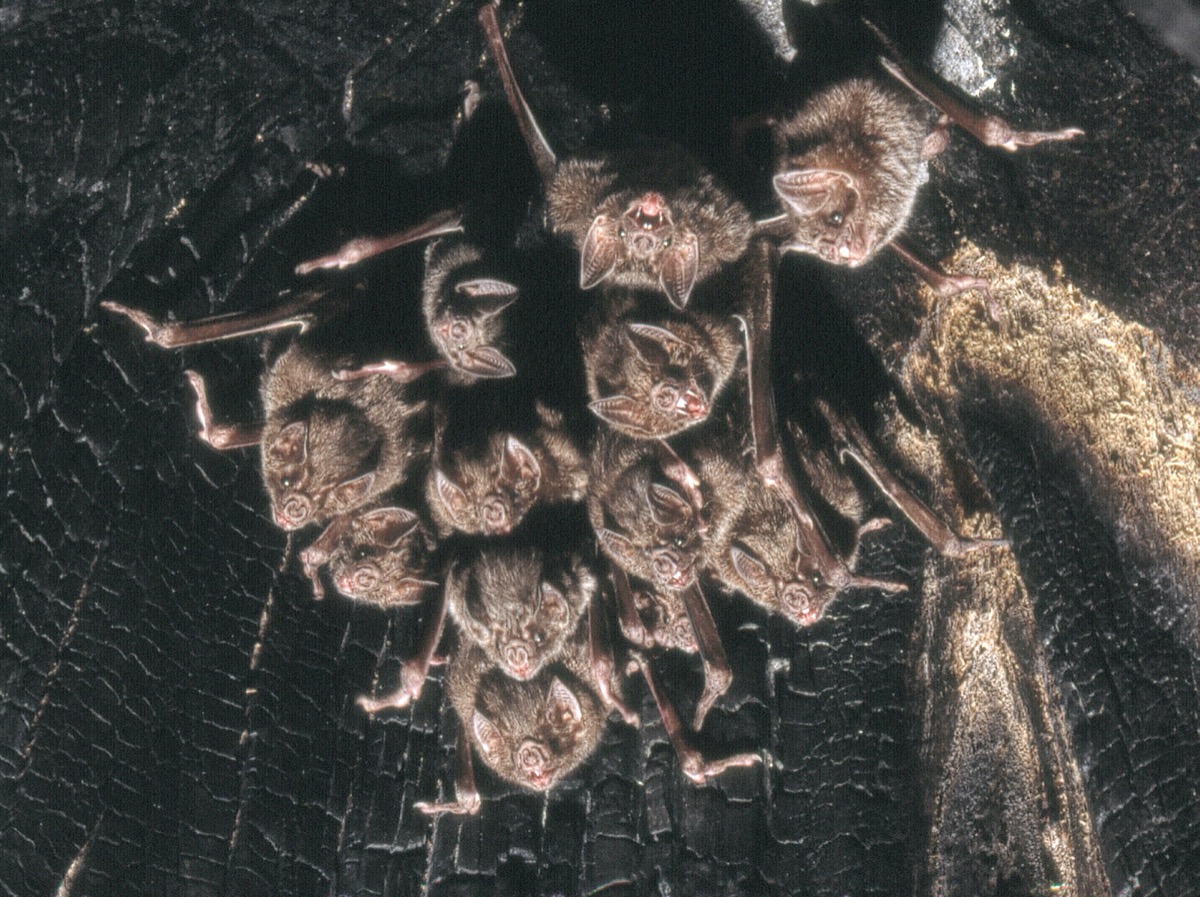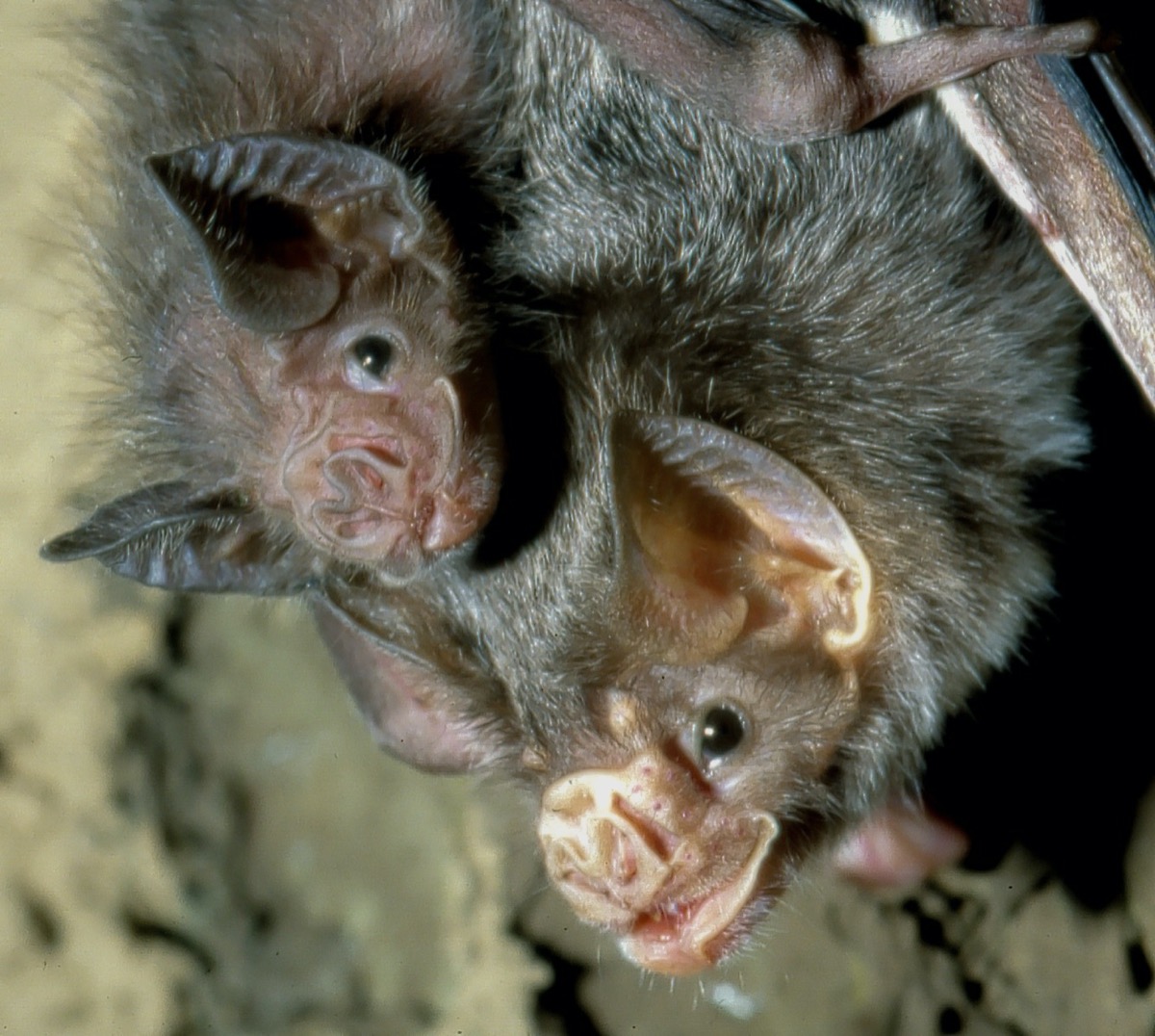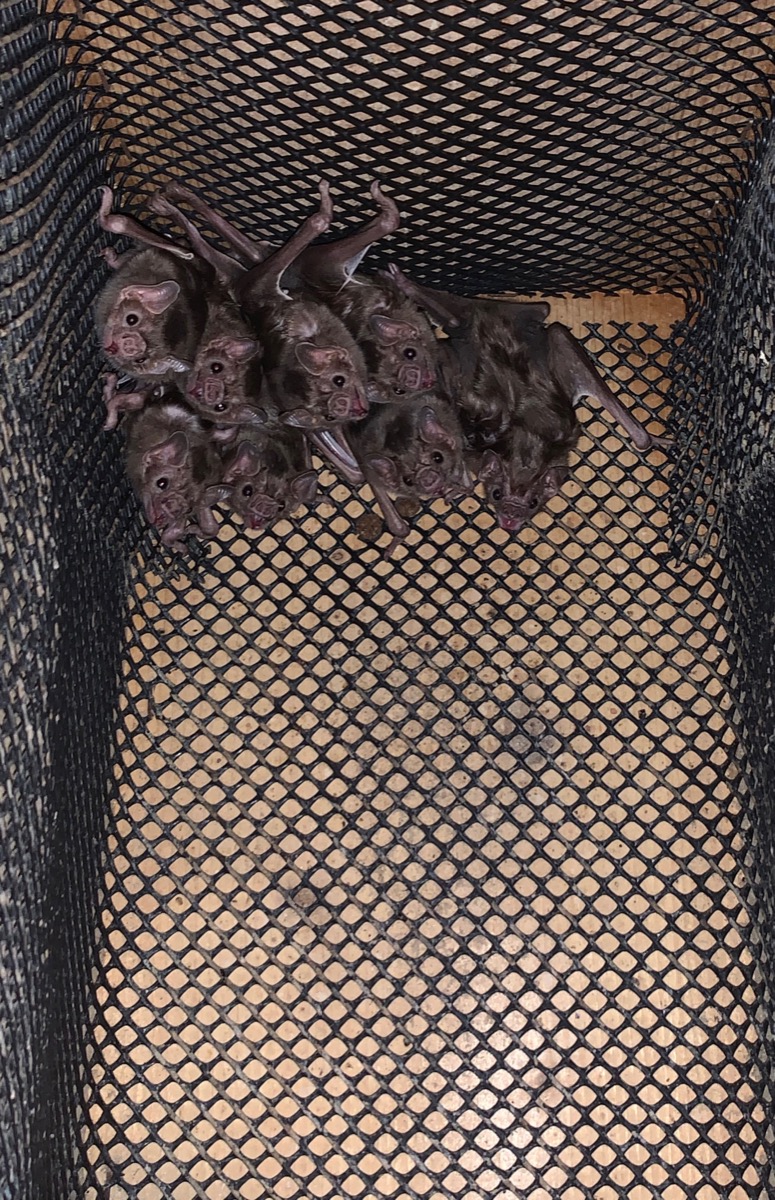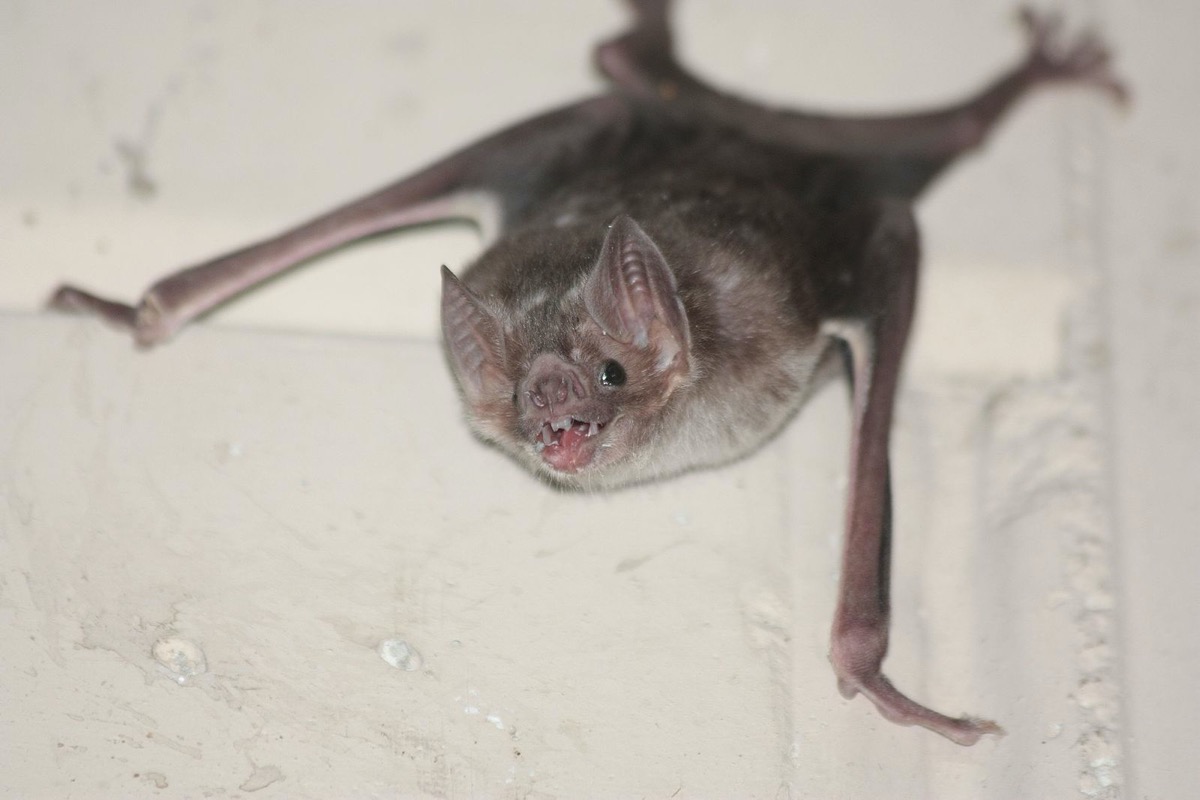What Can Vampire Bats Teach Us About Socializing In A Pandemic?
12:27 minutes

Vampire bats have complex social networks, forming relationships with other bats that can vary on a spectrum of cooperation and conflict. When bats are bonded, social behavior is expressed in two main ways: grooming and sharing food, which means regurgitating blood into another bat’s mouth.
Gerry Carter, an assistant professor in Ohio State University’s Department of Evolution, Ecology and Organismal Biology, studied vampire bats from two different regions of Panama to see how bats formed bonds as strangers.

“When we introduced them in isolated pairs they formed relationships much faster, like college students in a dorm room,” Carter said to Science Friday earlier this week. “And when we introduced a bat into a group of three, that was faster than when we just put two larger groups together.”
Carter has also studied how illness changes social relationships within a vampire bat roost. He found that if a baby bat gets sick, for instance, the mom won’t stop grooming or sharing food with their offspring. But that same bat will stop participating in some social behavior with a close roost-mate that isn’t family.
Carter joins Science Friday guest host John Dankosky to talk about researching vampire bats, and what their response to illness tells us about our own time social distancing during the coronavirus outbreak. See more photos and video of social bat behavior below.


Invest in quality science journalism by making a donation to Science Friday.
Gerald Carter is an Assistant Professor in the Department of Evolution, Ecology and Organismal Biology at the Ohio State University in Columbus, Ohio.
JOHN DANKOSKY: This is Science Friday. I’m John Dankosky, sitting in for Ira Flatow. And I just want to note here, Ira is fine. He’s just spending this week at home, like most of you. He had planned to go to spring training to see some baseball. And as they used to say about the Brooklyn Dodgers, you’re going to have to wait till next year. But you will not have to wait for Ira that long. He’s going to be back next week.
Later this hour, our experts will weigh in on this week’s coronavirus news stories, plus a little science poetry to cleanse the palate. But first, since we’re missing a lot of social contact these days, let’s talk about what we’ve learned from other social mammals.
Take vampire bats, for instance. Sometimes they get along, and sometimes they fight. When bats have strong bonds, they’ll do things like groom each other and share food by regurgitating blood into each other’s mouths, which sounds gross, unless you’re a bat.
But when a vampire bat gets sick, it changes the way other bats interact with them. In fact, the way they act is similar in some ways to how humans have reacted to COVID-19. Gerry Carter is an assistant professor and behavioral ecologist at Ohio State University. Gerry, welcome to Science Friday. Thanks so much for being here.
GERRY CARTER: Hi, yeah, thanks for inviting me.
JOHN DANKOSKY: So before we get started on connections to coronavirus, maybe you can give us an idea of just how social vampire bats are.
GERRY CARTER: Yeah, so they have this food-sharing behavior, which seems to be something that is an extension of parental care. So all the mothers regurgitate food– blood– to their offspring. But they also do this for other adults, including unrelated adults.
JOHN DANKOSKY: When you study these, when you study these vampire bats, you’re just studying the females, right?
GERRY CARTER: Yeah, we really focus on the females, because the females have these long-term social relationships with each other. The males tend to set up territories and then fight with other males over these territories, and they don’t seem to form very stable relationships with females or with other males.
JOHN DANKOSKY: Oh, that’s really interesting. So you might find something entirely different if you just studied male vampire bats.
GERRY CARTER: Yeah, it seems to be that the males are spending a lot of their time trying to gain access to different territories where the females aggregate, but the females are moving between different territories. So these can be, for instance, a location in a cave or a hollow tree. And the males don’t seem to be able to guard the females in any way. In fact, the females are a little larger than the males.
JOHN DANKOSKY: OK, OK. So let’s get to this idea. Vampire bats and coronavirus– not exactly things I would normally think about in the same sentence. How do these tie together?
GERRY CARTER: Well, there’s this social distancing that we’re all doing right now, which is really trying to change our social networks before we get sick. But when individuals do get sick, their social network also changes just as a byproduct of being lethargic. So you move around less. You encounter fewer individuals. And so that sickness behavior has an effect on social network structure itself.
And so this is something that we were looking at in the vampire bats. Other people have looked at it in mice. And we’ve also looked at how the kind of relationship that the bats have changes how the sickness of behavior affects their social ties. So the individuals that have stronger relationships, those relationships are going to be more robust than individuals that are spending a lot of time together but don’t necessarily have, for instance, a family relationship.
JOHN DANKOSKY: OK, so just like right now, you’re spending a lot of time with your family. But your coworkers, you’re not hardly spending any time with, and you’re really distanced from a sick coworker. That’s what you’re finding in vampire bats, too.
GERRY CARTER: Yeah, exactly. So the way that we typically would measure network ties is, for instance, the amount of time that you’re spending with other individuals. So you could be spending, say, some certain amount of time with your coworkers and some certain amount of time with your kids. But that doesn’t mean that those relationships are equivalent. Even though the amount of time you spend is the same, when you’re sick, you could be spending even more time with your kids or the same amount of time and much less time with coworkers.
And so this is something we were trying to show with vampire bats, that it’s not just the amount of time that defines the relationship, but also the kind of– you can think about it as a robustness, so how much the relationship changes when the individuals are feeling lethargic.
JOHN DANKOSKY: So tell us more about the changes in behavior. We talk about grooming and food sharing, different types of closeness. Tell us about some of the differences here, depending on the behaviors.
GERRY CARTER: So we actually did a series of studies on this. We basically injected the bats with something called lipopolysaccharide, which is on the cell wall of bacteria. And so it triggers their immune system. They get a fever, and they mount an immune response. They become lethargic, and they just sleep more and are less active. But there’s no live pathogen. So there’s no pathogen that’s manipulating their behavior in the same way that, for instance, rabies would manipulate their behavior. This is just the bats having sickness behavior.
And we saw how this changed their grooming and their social grooming. And then we sort of put them in different cages to control how much time they’re forced to be around each other. So we did this when they were in small cages, and then we also did this in a flight cage, where they could choose to associate with different bats. And now we’re doing it in the wild. So we have bats out in the field, and we’ve put little proximity sensors on them. And we can actually see, minute by minute, hour by hour, how the bats’ behavior is changing in the wild. But we haven’t published that last study yet.
JOHN DANKOSKY: This food-sharing behavior is important, because it’s not just, like, a nice thing that bats do for each other, but this is a real lifesaver, too. This is important for survival for some bats.
GERRY CARTER: Yeah, it’s interesting, because it’s a pretty rare thing to see in the animal world that animals are really paying a cost to cooperate with another individual. And so there’s some risk entailed in that. And that’s one of the reasons that we’re interested in vampire bats, is that it’s a really costly form of cooperation that would apply to some models that are interesting, because we want to figure out why it is that animals make a costly investment in another if there’s no immediate benefit to them. How do they sort of prevent themselves from being exploited?
JOHN DANKOSKY: And they start to warm up to this behavior, right? I mean, you’ve talked about this a little bit. But there’s the grooming behavior that would precede any food-sharing behavior. So it’s almost like these bats are getting to know each other a little bit more before they trust. Is it– I don’t know– is trust a word I can use?
GERRY CARTER: Yeah, I think you can think about it as a kind of trust. We were testing this model that people often called raising the stakes or testing the waters. And this is a game theory model which is describing a situation just like I had said, where cooperation is risky and entails a cost. So if you make a cooperative investment in another individual, and that individual doesn’t cooperate with you, you might be even worse off than if you had never engaged with that partner at all. So you can imagine all the different scenarios in which that’s the case.
And one strategy to minimize risk is, instead of putting all of your cooperation in one big pot, giving it up into lots of little small investments, so starting out with something really small. So maybe you just see if you’re tolerated by another individual, and then you groom a little bit. And then, if that goes well, you groom a little bit more. And so you’re gradually testing the waters and escalating these investments. So it’s conditionally on how you’re received. And this allows you to, yeah, build up this trust before you start making larger investments, larger, more risky investments.
JOHN DANKOSKY: I guess I’m wondering what you think all this means to vampire bats writ large. If the females are doing this sort of behavior, where they’re assessing risk and they’re thinking about what sort of relationship they want to have, and meanwhile, the males are just fighting over territory, I mean, what does that say about the species overall that that’s the dynamic there?
GERRY CARTER: Yeah, well, the females make a really large investment in offspring. So they have a much longer period of parental care than, for instance, other bats. They have a gestation period of seven months, which is a really long time for a small animal like that. They only have one offspring at a time.
And so there’s really this big reproductive cost that they’re paying to just maintain the energy and to produce milk. And so the males are really spending most of their time trying to just gain access to females, whereas for females, staying healthy and staying alive and keeping their offspring alive is really the key to their reproduction and their evolutionary fitness.
JOHN DANKOSKY: So there’s a lot of animals that are social in different ways. What is it you think about vampire bats that makes their social behavior more similar to humans than, say, I don’t know, ants?
GERRY CARTER: Yeah, well, vampire bats have a kind of social complexity that’s similar to the kind of social complexity you see in many primates or dolphins and whales or ravens and crows, elephants, animals that have these very individualized relationships, where there’s a mix of cooperation and conflict.
And that’s quite different from a truly eusocial society like ants or bees, where each individual is just living only for the colony. So individual ants or individual bees don’t really care about their own survival. They’re only trying to gather food for the brood and their colony.
And, of course, humans are not like that, and vampire bats are not like that. They have very differentiated relationships, individuals they get along with and other ones they don’t. And so they’re really kind of navigating this complex social environment, trying to have mutually beneficial interactions, but also avoid costly interactions, and also competing with each other in subtle ways as well.
JOHN DANKOSKY: And one of the things you found that’s so interesting is, if you had a bat from one place and a bat from another place, you put them together, and they’re strangers. They might learn to get along. But if you put a whole bunch of bats from one place next to a whole bunch of bats from another place, just like humans, they’d get into cliques or groups of some sort.
GERRY CARTER: Yeah, the outside options really matter. So bats that don’t have familiar partners that they could be associating with and are only presented with another stranger, they’re more likely to start interacting with that stranger and then form a relationship because of that. So this is something that we’re starting to think about more and more as this sort of market of possible partners that are available to you when you’re making decisions about what kinds of relationships you’re going to form.
JOHN DANKOSKY: Really quickly, why did you start studying vampire bats in the first place?
GERRY CARTER: So I’ve actually been really fascinated by bats ever since I was a little kid. It’s one of my youngest memories, is seeing a bat. And yeah, as I got interested in animal behavior and cooperation, it just made sense to combine my interest in cooperation with my interest in bats.
JOHN DANKOSKY: Well, and I’m glad you’re able to bring us a little social science that helps us in this very antisocial times, it seems. Gerry Carter studies the social lives of vampire bats at Ohio State University in Columbus, Ohio. Gerry, thanks so much for joining us. I really appreciate it.
GERRY CARTER: Thanks for having me.
JOHN DANKOSKY: When we come back, are you feeling swamped in coronavirus news, having a hard time telling what’s real and what is, well, speculation? We’ve got a few experts here to help you fact check your news feed. It’s coming up right after this.
[LIVELY MUSIC]
This is Science Friday from WNYC Studios.
Copyright © 2020 Science Friday Initiative. All rights reserved. Science Friday transcripts are produced on a tight deadline by 3Play Media. Fidelity to the original aired/published audio or video file might vary, and text might be updated or amended in the future. For the authoritative record of Science Friday’s programming, please visit the original aired/published recording. For terms of use and more information, visit our policies pages at http://www.sciencefriday.com/about/policies/
Kathleen Davis is a producer and fill-in host at Science Friday, which means she spends her weeks researching, writing, editing, and sometimes talking into a microphone. She’s always eager to talk about freshwater lakes and Coney Island diners.
John Dankosky works with the radio team to create our weekly show, and is helping to build our State of Science Reporting Network. He’s also been a long-time guest host on Science Friday. He and his wife have three cats, thousands of bees, and a yoga studio in the sleepy Northwest hills of Connecticut.